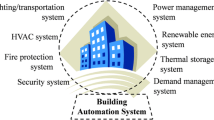Abstract
Building, heating, ventilation, and air-conditioning (HVAC) consumes nearly 48% of the entire building energy of the world. Improvement in the control strategy of an HVAC system can result in substantial energy savings, which is the motivation behind this research. In this study, a decentralized method is proposed to search for a good-enough control strategy to reduce the energy consumption of a typical HVAC system consisting of cooling towers, chillers, pumps, and air handling units (AHUs). The method is then compared to a centralized method. In addition to energy consumption, indoor environmental factors such as temperature and humidity are considered in the new method to meet the requirements of human comfort. We introduce experimental conditions for feasibility and the crude energy index in the decentralized method to reduce the computational time. The improved HVAC system was able to save 34% (per 12 h) on energy consumption and the average computational time was reduced to 1247.5 s, which proves the efficiency and effectiveness of the decentralized method and the performance of the proposed control strategy.
Similar content being viewed by others
References
Abdalla EAH, Nallagownden P, Nor NM, Romlie MF, Abdalsalam ME, Muthuvalu MS (2016). Intelligent approach for optimal energy management of chiller plant using fuzzy and PSO techniques. In: Proceedings of the 6th International Conference on Intelligent and Advanced Systems, Kuala Lumpur, Malaysia.
Athienitis AK, Tzempelikos A (2001). A methodology for detailed calculation of room illuminance levels and light dimming in a room with motorized blinds integrated in an advanced window. In: Proceedings of the National Building Simulation Conference, Ottawa, Canada.
Bee E, Prada A, Baggio P, Psimopoulos E (2019). Air-source heat pump and photovoltaic systems for residential heating and cooling: Potential of self-consumption in different European climates. Building Simulation, 12: 453–463.
Brooks J, Kumar S, Goyal S, Subramany R, Barooah P (2015). Energy-efficient control of under-actuated HVAC zones in commercial buildings. Energy and Buildings, 93: 160–168.
Chang I-S, Wang X, Wei Q-F (2008). The COP index of chiller in large public buildings: Measurement and application. In: Proceedings of the Academic Annual Conference on the National HVAC. (in Chinese)
Dai Y-C, Jiang Z-Y, Shen Q, Chen PZ, Wang SQ, Jiang Y (2016). A decentralized algorithm for optimal distribution in HVAC systems. Building and Environment, 95: 21–31.
Dai Y-C, Jiang Z-Y, Wang S (2017). Decentralized control of parallel-connected chillers. Energy Procedia, 122: 86–91.
DeST (2008). DeST Software. Tsinghua University. Available at http://www.dest.com.cn.
He S, Gurgenci H, Guan Z, Hooman K, Zou Z, Sun F (2016). Comparative study on the performance of natural draft dry, pre-cooled and wet cooling towers. Applied Thermal Engineering, 99: 103–113.
Ho Y-C, Zhao Q-C, Jia Q-S (2007). Ordinal Optimization: Soft Optimization for Hard Problems. New York: Springer.
IEA (2018). World Energy Investment 2018. International Energy Agency. Available at https://www.iea.org.
Liu Z, Chen X, Xu X, Guan X (2013). A decentralized optimization method for energy saving of HVAC system. In: Proceedings of IEEE International Conference on Automation Science and Engineering (CASE), Madison, WI, USA.
Liu Z, Song F, Jiang Z, Chen X, Guan X (2014). Optimization based integrated control of building HVAC system. Building Simulation, 7: 375–387.
Liu Z-H, Tan H-W, Luo D, Yu G-B, Li J, Li Z-Y (2017). Optimal chiller sequencing control in an office building considering the variation of chiller maximum cooling capacity. Energy and Buildings, 140: 430–442.
Lu L, Cai W-J, Chai Y-S, Xie L-H (2005a). Global optimization for overall HVAC systems—Part I problem formulation and analysis. Energy Conversion and Management, 46: 999–1014.
Lu L, Cai W-J, Chai Y-S, Xie L-H (2005b). Global optimization for overall HVAC systems—Part II problem solution and simulations. Energy Conversion and Management, 46: 1015–1028.
Su Y, Su R, Polla K (2014). Distributed scheduling for efficient HVAC pre-cooling operations. In: Proceedings of the 19th World Congress of the International Federation of Automatic Control, Cape Town, South Africa, pp. 10451–1456.
Sun B, Luh P-B, Jia Q-S, Jiang Z-Y, Wang F-L, Song C (2013). Building energy management: integrated control of active and passive heating, cooling, lighting, shading, and ventilation systems. IEEE Transactions on Automation Science and Engineering, 10: 588–602.
Tsinghua University (2010). Annual Report on China’s Building Energy Efficiency. Beijing: China Architecture & Building Press. (in Chinese)
Wu D, Jia Q-S (2014). Sample path sharing in policy improvement for indoor air temperature control. IFAC Proceedings Volumes, 47: 247–252.
Xu X, Jia Q, Xu Z, Zhang B, Guan X (2016). On joint control of heating, ventilation, and air conditioning and natural ventilation in a meeting room for energy saving. Asian Journal of Control, 18: 1781–1804.
Xue Z-F, Jiang Y (2007). Energy-Saving Diagnosis and Retrofit in Existing Building. Beijing: China Architecture & Building Press. (in Chinese)
Yao Y, Chen J (2010). Global optimization of a central air-conditioning system using decomposition-coordination method. Energy and Buildings, 42: 570–583.
Zhang H-G, Cai L-L (2002). Decentralized nonlinear adaptive control of an HVAC system. IEEE Transactions on Systems, Man and Cybernetics, Part C (Applications and Reviews), 32: 493–498.
Zhao RY, Fan CY, Xue DH (2009). Air Conditioning. Beijing: China Architecture & Building Press. (in Chinese)
Zhuang L, Chen X, Guan X (2017). A bi-level optimization for an HVAC system. Cluster Computing, 20: 3237–3249.
Zhuang L, Chen X, Guan X (2018). Regression model of heat exchange efficiency of cooling tower in an HVAC system, Control and Decision, 33: 1801–1806. (in Chinese)
Acknowledgements
This work was supported in part by the National Key Research and Development Program of China (2016YFB0901900 and 2017YFC0704100).
Author information
Authors and Affiliations
Corresponding author
Electronic Supplementary Material
Rights and permissions
About this article
Cite this article
Zhuang, L., Chen, X. & Guan, X. A decentralized method for energy conservation of an HVAC system. Build. Simul. 13, 155–170 (2020). https://doi.org/10.1007/s12273-019-0569-6
Received:
Revised:
Accepted:
Published:
Issue Date:
DOI: https://doi.org/10.1007/s12273-019-0569-6




